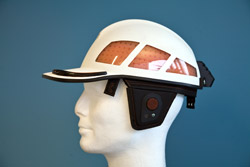The “thinking” safety helmet

The helmet is lined on the inside with a material that is soft and flexible under normal conditions, but which “locks” instantaneously, becoming hard and shock-absorbent, if the helmet is subjected to impact or blows.
Industrial designer Tore Christian Bjørsvik Storholmen at SINTEF Health Research felt that workers in the building and construction industry deserved a helmet that is smarter than current models – in more than one sense.
Now, the 27-year-old designer has won an award from the Norwegian Design Council for his “ProActive” helmet.
Talent competition award
The helmet took third prize in “Young talents – open class” at this year’s
design awards ceremony in Oslo on March 12.
More than one hundred candidates had submitted their contributions to this class, which covers designs ranging from clothing to furniture.
New shape
“As far as appearance is concerned, safety helmets have not altered much in the course of the past 30 years. The shape of my concept was inspired by the baseball cap which has long been popular headgear in the construction industry”, explains Storholmen.
He chose this design because he was well aware that workers are more likely to wear protective equipment that they feel comfortable wearing. However, the “smart” concept refers to more than the appearance of the new helmet.
Smart material
The helmet is lined on the inside with a material that is soft and flexible under normal conditions, but which “locks” instantaneously, becoming hard and shock-absorbent, if the helmet is subjected to impact or blows.
“The material on the inside makes my helmet more comfortable in everyday use, and at the same time, safer than traditional models”, says the prize-winner.
And in line with the spirit of the times, Storholmen has made parts of the outer shell transparent, so that the shock-absorbent material is visible from the outside.
Smart ear protection
SINTEF’s new employee has also used smart materials in the ear-protectors that form part of the helmet. Both the ear-protectors themselves and the “loop” that is used to charge up instruments in the helmet are made of textiles that can conduct electricity.
“This means that communication systems can be incorporated in the helmet without the need for cables that could become caught up in other things,” says Storholmen.
Radio or intercom links or gas detectors can all be mounted on the helmet according to the requirements of the individual user.
A combination of pressure-sensitive textiles and Bluetooth technology means that the user can answer a mobile phone call without having to remove his gloves, ear protectors and helmet.
Student project
Tore Christian Bjørsvik Storholmen graduated last year as M.Sc. (Eng.) from NTNU’s industrial design course. The ProActive helmet is the result of a student project that formed part of the course.
“We chose our topics ourselves. Since I have a brother in the construction industry I realised that a lot of people are uncomfortable wearing traditional safety helmets,” says the young prize-winner.
Multidisciplinary group effort
Storholmen is now with SINTEF Health Research’s Work Physiology section, where he works on SmartWear, which is one of six areas of special effort in the SINTEF Group. The aim here is to develop two types of smart clothing:
• Clothing with integrated instrumentation, i.e. with inbuilt sensors and communication equipment.
• Clothing made of functional materials, i.e. materials that give clothes new properties when the temperature changes or when there are other alterations in the user’s environment .
SmartWear is a multidisciplinary effort, in which SINTEF scientists in ICT, materials science, physiology and product design cooperate across the boundaries of their own particular disciplines.
by Svein Tønseth
Media Contact
More Information:
http://www.sintef.comAll latest news from the category: Awards Funding
Newest articles

First-of-its-kind study uses remote sensing to monitor plastic debris in rivers and lakes
Remote sensing creates a cost-effective solution to monitoring plastic pollution. A first-of-its-kind study from researchers at the University of Minnesota Twin Cities shows how remote sensing can help monitor and…

Laser-based artificial neuron mimics nerve cell functions at lightning speed
With a processing speed a billion times faster than nature, chip-based laser neuron could help advance AI tasks such as pattern recognition and sequence prediction. Researchers have developed a laser-based…

Optimising the processing of plastic waste
Just one look in the yellow bin reveals a colourful jumble of different types of plastic. However, the purer and more uniform plastic waste is, the easier it is to…



